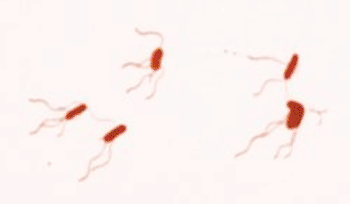Molecular Assays Developed to Differentiate Bordetella Species
By LabMedica International staff writers
Posted on 12 Feb 2014
Bordetella parapertussis is a causative agent of whooping cough or pertussis in humans and B. bronchiseptica causes a wide variety of respiratory infections in mammals including humans, and a specific diagnostic assay would be useful for routine use or for use in reference laboratories.Posted on 12 Feb 2014
The presence of B. bronchiseptica can confound current molecular B. pertussis or B. parapertussis diagnostic test results and although B. bronchiseptica may be rare, its prevalence is not known with any certainty, and it may cause erroneous diagnosis, in particular in adolescents and adults.

Image: Photomicrograph of Bordetella bronchiseptica using Leifson flagella stain (Photo courtesy of William A. Clark).
Scientists at the Institute of Chemical Technology (Prague, Czech Republic) with colleagues in France collected reference strains of B. bronchiseptica, B. parapertussis, B. pertussis, and B. petrii, B. holmesii, and clinical isolates of these species and sputum samples collected from patients with confirmed B. bronchiseptica infection by culture.
Clinical isolates and reference strains were cultivated at 36 °C for 48 hours (B. bronchiseptica, B. parapertussis, and B. petrii) to 72 hours (B. pertussis and B. holmesii) on Bordet Gengou agar containing 15% defibrinated sheep blood. Bacterial DNA was isolated with DNeasy blood and tissue kits (Qiagen GmbH; Hilden, Germany). Multilocus sequence typing (MLST) was also performed. A real-time polymerase chain reaction (PCR) assay was carried out and analyzed on the LightCycler 480 (Roche Applied Science; Penzberg, Germany).
Analysis of the sequences revealed a region that is highly conserved in the genomes of all clinical isolates of B. bronchiseptica and B. parapertussis. This region contains regulatory sites, including a ribosome-binding site and polymerase-binding site. The targeted region of several clinical isolates of both species was sequenced and alignment of the sequences allowed the development of a two-step real-time PCR assay. The sensitivity of this real-time PCR assay for detection of B. bronchiseptica/B. parapertussis and B. parapertussis was 24 and 22 colony forming units (CFU) per reaction, respectively.
The authors concluded that the first PCR assay detected the DNA of all clinical isolates of both B. bronchiseptica and B. parapertussis tested. The second PCR assay detected only the DNA of B. parapertussis clinical isolates, thereby allowing discrimination between B. parapertussis and B. bronchiseptica. The study was published on January 14, 2014, in the journal Diagnostic Microbiology and Infectious Disease.
Related Links:
Institute of Chemical Technology
Qiagen GmbH
Roche Applied Science














